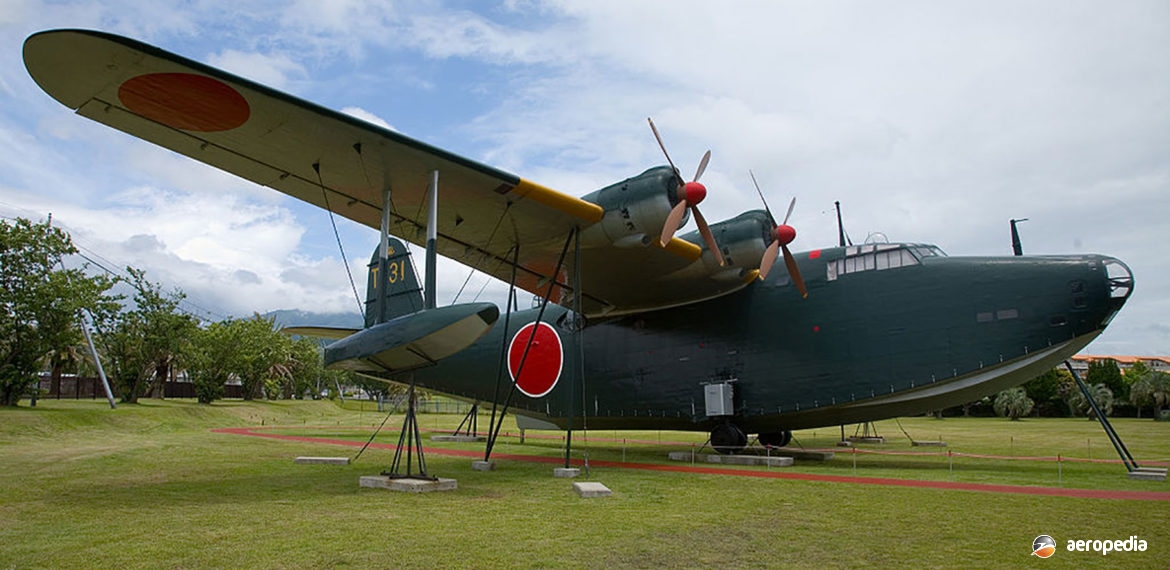Photograph:
Kawanishi H8K Emily at the Kanoya Museum in Japan (Max Smith)
Country of origin:
Japan
Description:
Long-range four-engine military flying-boat
Power Plant:
Four 1,380 kw (1,850 hp) Mitsubishi MK4Q Kasei 22 fourteen-cylinder two-row air-cooled radial engines
Specifications:
- Wingspan: 38 m (124 ft 8 in)
- Length: 28.12 m (92 ft 3½ in)
- Height: 9.15 m (30 ft 0¼ in)
- Wing area: 160 m² (1,722.28 sq ft)
- Max speed at 5,000 m (16,405 ft): 454 km/h (282 mph)
- Max continuous cruising speed at 4,000 m (13,125 ft): 295 km/h (184 mph)
- Landing speed: 130 km/h (81 mph)
- Time to climb to 5,000 m (16,405 ft): 10.4 mins
- Service ceiling: 8,780 m (28,805 ft)
- Normal radius of action: 2,352 km (1,460 miles)
- Max range on reconnaissance mission with overload fuel: 7,150 km (4,443 miles)
- Empty weight: 18,200 kg (40,123 lb)
- Loaded weight: 24,500 kg (54,012 lb)
- Max take-off weight: 32,500 kg (71,649 lb)
History:
In August 1938 the Imperial Japanese Navy issued an order for a successor to be designed and built to replace the Navy Type 97 Flying Boat Model I, this requiring a cruising range of 7,410 km (4,604 miles), a heavy armament, and the ability to carry two 1,000 kg (2,204 lb) torpedoes or bombs. A team, led by Dr Shizuo Kikuhara, designed the H8K with four engines, range being achieved by installing fuselage and wing tanks providing 17,040 litres (3,748 Imp gals) of fuel.
On 29 December 1940 the prototype of the 13-Shi flying boat, as it was known, was flown at the Kohnan plant of Kawanishi near Osaka. However, some problems needed to be dealt with before it entered production, and a number of changes were made to the design. An initial production batch of 12 aircraft was laid down, later aircraft having Mitsubishi MK4Q Kasei 22 engines with water-injection, providing 1,380 kw (1,850 hp).
The Emily began military operations in 1942, it later being described as “the most heavily defended and fastest flying-boat serving with any of the combatants, and was destined to remain so until the end of the Pacific conflict”.
On 20 July 1942 the Yokohama Ku (Kokutai), which had been the first unit equipped with the type, moved to Rabaul in New Britain with No 14-Ku, a detachment of the Yokosuka-Ku, which at that stage was equipped with the H6K4 Mavis, to carry out reconnaissance and night missions over the New Hebrides, New Caledonia and Fiji. In August No 14-Ku began to re-equip with the H8K1.
On 1 October 1942 No 14-Ku became 802-Ku and the Yokosuka and Yokohama Kus were re-designated 851-Ku and 810-Ku a month later. These units subsequently performed many of the long-range flying-boat operations in the Pacific war, many of these being of long distances, such as attacks on the United States fleet at Espiritu Santo Island; from Jaluit Island to the Shortland Islands; and to the Phoenix Islands, distances of up to 1,850 km (1,150 miles). Some were of up to 18 hours duration and, it was said, reconnaissance missions were made along the Australian west coast, culminating on 17 August 1943 with an Emily bombing the Broome aerodrome, WA.
Three bombing raids were made on Townsville, QLD and reports indicated these were made by Rabaul-based H8K2 Emilys, whereas for many years it was thought the raids were made by Mavis flying boats.
To meet requirements for a long-range transport around the Pacific islands, the H8K1 prototype was modified in late 1943, having the dorsal turret and side blisters removed, and windows cut in the hull, thus providing seating for 41 on two decks.
Production began of the H8K2 transport variant at the Kawanishi Naruo plant, this becoming the H8K2-L, or Type 2 transport flying-boat Seiku (Clear Sky) Model 32. Some 36 were delivered by the end of the war. With a crew of nine, 29 passengers and 1,705 kg (3,760 lb) of freight, it had a normal range of 2,224 km (1,382 miles). During the Japanese evacuation of Rabaul a number of these transports were involved, on one night transporting 600 troops.
Production of the type was not swift by any standards, only six or seven a month being completed, 80 being delivered during 1943. With American attacks commencing on the Japanese mainland and islands closer to Japan, the production of the Emily was slowed to allow concentration on the N1K2-J Shiden Kay fighter for defence of the homeland. As Allied fighters gained mastery of the air the Emily was relegated to nocturnal bombing and reconnaissance missions, where they ran into radar-equipped fighters and losses began to escalate. At that stage of the war replacements were not available. In the closing months of the war the Japanese Imperial Navy lost 25 of the surviving 28 Type 2 flying-boats, 15 in combat.
The most famous operation of the H8K series was on 5 March 1942 when four bombs were dropped on the slopes of Mount Tantalus, Oahu Island, Hawaii and another four on Pearl Harbour. Referred to as ‘Operation K’, two prototypes (serials Y-72 and Y-73) of the Yokohama Kokutai (Air Corps) were flown from Wotje on Jaluit Island in the Marshall Group in February, on 4 March flying to the French Frigate Shoals, some 925 km (575 miles) from Hawaii, where they refuelled from submarines, continuing on to Hawaii. A further similar operation was to be attempted three months later but, when the submarine arrived at the Shoals, it found it was being used by United States Navy seaplane tenders.
When war ended, three survived at Takuma in Japan and one was made airworthy for testing by United States units. This aircraft, an H8K Type 2 Flying Boat Model 12, remained stored at Norfolk Naval Air Station in Virginia for many years until transferred to the Museum of Maritime Science in Tokyo, where it has been restored and placed on display.

